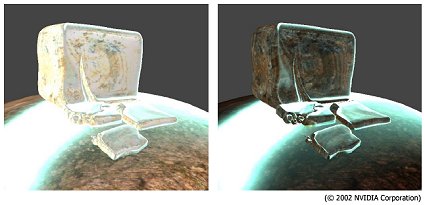GeForceFX: NVIDIA goes Hollywood?
Intellisample
This is the name NVIDIA has given the GeForceFX's image quality optimizations. These encompass the filtering techniques mentioned earlier when we discussed the pixel pipelines, as well as edge-smoothing techniques (antialiasing).
Color Compression
As we mentioned before, the GeForceFX's memory interface incorporates a lossless color compression technique, which can compress color data at a factor of 4:1 in real-time, i.e., without a performance penalty. Memory bandwidth can therefore be utilized more effectively and overall performance increases. Pixels assigned a fixed color value within a polygon can profit from this compression. The saved memory bandwidth is instead available for rendering pixels on the polygon's edge.
Antialiasing
The GeForceFX has been outfitted with new antialiasing modes. In addition to 6XS, a new 8x mode is available which uses twice as many pixels to calculate an image as 4x mode. Thanks to the lossless Z and color compression, antialiasing is much faster on the GeForceFX than on its predecessor. NVIDIA promises that in practice even 8x mode will be usable without frame rates dropping to abysmal levels. Beyond that, NVIDIA also uses gamma correction. The AA filter is very variable in many respects. The texture crispness (sharpness) can be manipulated through a higher number of samples and better filtering, as well as through the use of high-definition mipmaps. Since each pipeline can calculate up to 1024 texture operations in one pass, filtering techniques can be very complex without having too much of a negative impact on performance.
Dynamic Color Correction
This new feature of the GeForceFX simplifies the treatment of Gamma levels in shader calculations. It saves the developer the inconvenient task of having to take gamma-spaces into consideration.
Without gamma correction on the left. Corrected on the right.
Get Tom's Hardware's best news and in-depth reviews, straight to your inbox.
